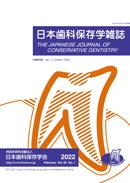Volume 65, Issue 2
Displaying 1-10 of 10 articles from this issue
- |<
- <
- 1
- >
- >|
Symposium in the Journal
-
2022 Volume 65 Issue 2 Pages 103
Published: April 30, 2022
Released on J-STAGE: April 30, 2022
Download PDF (137K) -
2022 Volume 65 Issue 2 Pages 104-108
Published: April 30, 2022
Released on J-STAGE: April 30, 2022
Download PDF (1760K) -
2022 Volume 65 Issue 2 Pages 109-114
Published: April 30, 2022
Released on J-STAGE: April 30, 2022
Download PDF (7371K) -
2022 Volume 65 Issue 2 Pages 115-119
Published: April 30, 2022
Released on J-STAGE: April 30, 2022
Download PDF (6180K)
Original Articles
-
2022 Volume 65 Issue 2 Pages 120-133
Published: April 30, 2022
Released on J-STAGE: April 30, 2022
Download PDF (441K) -
2022 Volume 65 Issue 2 Pages 134-144
Published: April 30, 2022
Released on J-STAGE: April 30, 2022
Download PDF (2592K) -
2022 Volume 65 Issue 2 Pages 145-153
Published: April 30, 2022
Released on J-STAGE: April 30, 2022
Download PDF (9827K) -
2022 Volume 65 Issue 2 Pages 154-163
Published: April 30, 2022
Released on J-STAGE: April 30, 2022
Download PDF (1086K) -
2022 Volume 65 Issue 2 Pages 164-173
Published: April 30, 2022
Released on J-STAGE: April 30, 2022
Download PDF (282K)
Case Report
-
2022 Volume 65 Issue 2 Pages 174-183
Published: April 30, 2022
Released on J-STAGE: April 30, 2022
Download PDF (2892K)
- |<
- <
- 1
- >
- >|
